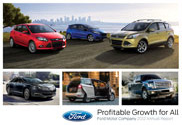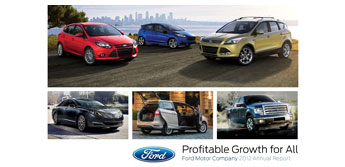
K. Venkatesh Prasad, group and senior technical leader, Vehicle Design and Infotronics, Ford Research and Innovation
- Who: K. Venkatesh Prasad, group and senior technical leader, Vehicle Design and Infotronics, Ford Research and Innovation
- Role: Leader of the team responsible for research and architecture of electrical, electronics and embedded software technologies. Member of Ford’s 12-person global Technology Advisory Board, chaired by the CTO
- Did you know? Prasad, a Silicon Valley transplant, who openly admitted to knowing little about the automobile when he joined Ford in 1996, is one of the masterminds behind the successful Ford SYNC® in-car connectivity system
Related Story: Ford and Bug Labs Develop Open-Source R&D Platform for Socially-Networked In-Car Connectivity Innovation
As the group and senior technical leader of Vehicle Design and Infotronics for Ford Research and Innovation, the birthplace of Ford SYNC®, K. Venkatesh Prasad is Ford’s “What’s Next” guy, responsible for the research, architecture, standards, applications development and vehicle system integration of electrical, electronics and embedded software technologies.
In the early 1960s he was just a small boy in Chennai, India, who was fascinated with electricity. As a precocious five-year-old undeterred by his parents’ heed to not play with wires, Prasad conducted his first experiment with electrons by plugging two wet shoelaces into a 220-volt power outlet.
“That shocking lesson stays etched in my mind today,” he said.
Before joining Ford Motor Company in 1996, Prasad worked as a senior scientist at RICOH Innovations in Menlo Park, Calif., developing automatic “lip reading” as a novel human-machine interface. In addition, he was at Caltech and the NASA Jet Propulsion Laboratory in Pasadena, Calif., where he worked on the world’s first telerobotic visual surface inspection system to help design the International Space Station.
Attracted by an open-ended challenge to discover ways to integrate “intelligence” into cars and trucks, Prasad joined Ford to work with a small group of engineers in the development of adaptive headlamp and lane-mark detection technologies.
“When I first met with Ford decision makers, they asked me what I knew about cars and I told them, ‘Not much.’ They said, ‘That’s who we need… we have 15,000 engineers here who know everything about cars and trucks. What we need is someone from outside our box to help us make our products safer, cleaner and the journey more fun.’ That intrigued me,” said Prasad.
As Ford’s What’s Next guy, Prasad in the late 1990s was imagining the vehicle as a software platform where features and services could be beamed in from the outside – without incremental built-in hardware. This was during the time when others were hot to find better ways to build in phones and trunk-mounted six-disc CD changers.
“In early 2000, formats started to change drastically – no longer were mechanical devices necessary to play music, only a piece of software. Everyone started carrying cellphones,” he says. “I envisioned transforming the move-alone vehicle into an inter-networked platform-on-wheels so people could use the devices they already had in their vehicle and reduce the steps needed to do things. Such connectivity required a revolutionary change of thinking.”
That revolutionary mind-set led to the development of Ford SYNC. Software-based, the voice-activated SYNC system allows Ford and Lincoln vehicle owners to seamlessly connect to their cellphone, MP3 players and a host of other features and services in and through their vehicle – hands-free.
For the What’s Next guy at Ford, the upgradeable SYNC platform is only limited by the imagination and market acceptance of emerging digital connectivity technologies.
“SYNC is helping Ford redefine the automotive user experience,” said Prasad. “Our challenge is to make sure we leverage the capabilities of the SYNC platform so that all functionality in the vehicle is safe and without distraction to the driver.”
Personal Insights and Fun Facts
- Prasad earned a Ph.D. in electrical and computer engineering from Rutgers University in New Brunswick, N.J., in 1990, and a master’s degree from Washington State University, Pullman
- Before coming to the U.S., in 1984, he obtained engineering degrees from IIT-Madras (1984) and NIT-Trichy (1980)
- Prasad lives with his wife and daughter in Ann Arbor, Mich., and they enjoy hiking the world – mostly in the wild outdoors
###
About Ford Motor Company
Ford Motor Company, a global automotive industry leader based in Dearborn, Mich., manufactures or distributes automobiles across six continents. With about 166,000 employees and about 70 plants worldwide, the company's automotive brands include Ford and Lincoln. The company provides financial services through Ford Motor Credit Company. For more information regarding Ford's products, please visit www.ford.com.
May 18, 2011









